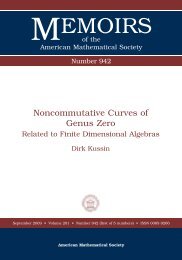University of Paderborn Department of Mathematics Diploma Thesis ...
University of Paderborn Department of Mathematics Diploma Thesis ...
University of Paderborn Department of Mathematics Diploma Thesis ...
Create successful ePaper yourself
Turn your PDF publications into a flip-book with our unique Google optimized e-Paper software.
4.5. COMPUTING STABLE IDEALS TO A GIVEN HILBERT POLYNOMIAL 111The associated prime ideals are Rad q 2,1 = (x 0 , x 1 ) and Rad q 2,2 = (x 0 , x 1 , x 2 ). Hence,R/q 2,1 describes an irreducible surface and R/q 2,2 a curve support on a line in P 4 .Thus, R/I 2 corresponds to the union <strong>of</strong> a surface and a curve in P 4 , where the curveis embedded into the support <strong>of</strong> the surface.I 3 – Again, as the ideal I 2 , I 3 is not a primary ideal. Its primary decomposition isI 3 = (x 0 , x 4} {{ 1) ∩ (x 2} 0, x 0 x 1 , x 4 1, x 2} {{ 2)}=:q 3,1=:q 3,2,where Rad q 3,1 = (x 0 , x 1 ) and Rad q 3,2 = (x 0 , x 1 , x 2 ). It follows that R/q 3,1 againdefines an irreducible surface and R/q 3,2 describes a curve support on a line. Hence,R/I 3 corresponds to the union <strong>of</strong> a surface and a curve in P 4 , where the curve isembedded into the support <strong>of</strong> the surface.I 4 – The ideal I 4 is also not a primary ideal. The primary decomposition is given byI 4 = (x 0 , x 4} {{ 1) ∩ (x 2} 0, x 0 x 1 , x 5 1, x 2 )} {{ }=:q 4,1=:q 4,2.We obtain Rad q 4,1 = (x 0 , x 1 ) and Rad q 4,2 = (x 0 , x 1 , x 2 ). As above, R/q 4,1 definesan irreducible surface. R/q 4,2 defines a curve support on a line, such that – as in theupper cases – R/I 4 corresponds to the union <strong>of</strong> a surface and a curve in P 4 , wherethe curve is embedded into the support <strong>of</strong> the surface.Note that we have q 2,1 = q 3,1 = q 4,1 = (x 0 , x 4 1), i.e. the ideal (x 0 , x 4 1) appears is any <strong>of</strong> theprimary decompositions <strong>of</strong> I 2 , I 3 and I 4 . As we saw above, R/(x 0 , x 4 1) defines an irreduciblesurface <strong>of</strong> degree 4. Although, (x 0 , x 4 1) does not appear in a primary decomposition <strong>of</strong> I 1(I 1 is a primary ideal itself), we saw that I 1 also defines a irreducible surface <strong>of</strong> degree 4.In order to distinguish between the geometric objects defined by R/I 1 , R/I 2 , R/I 3 andR/I 4 , we additionally compute their Hilbert polynomials and the first 10 values <strong>of</strong> theirHilbert functions: We obtain (e.g. by using procedure compute Hilbert polynomial presentedin 4.3):p R/I1 (z) = 2z 2 + 2z + 1, p R/I2 (z) = 2z 2 + 2z − 5,p R/I3 (z) = 2z 2 + 2z + 1, p R/I4 (z) = 2z 2 + 2z − 1.As expected, the four Hilbert polynomials only differ within their constant terms. Wehave p R/I1 (z) = p R/I3 (z), whereas p R/I2 (z) and p R/I4 (z) differ from each other and fromthe Hilbert polynomial <strong>of</strong> R/I 1 respectively R/I 3 . To see, from which point on the values<strong>of</strong> the Hilbert functions equal those <strong>of</strong> the Hilbert polynomial (the differences have beenunderlined below), we state the first ten values <strong>of</strong> the Hilbert functions <strong>of</strong> R/I 1 , R/I 2 , R/I 3
















